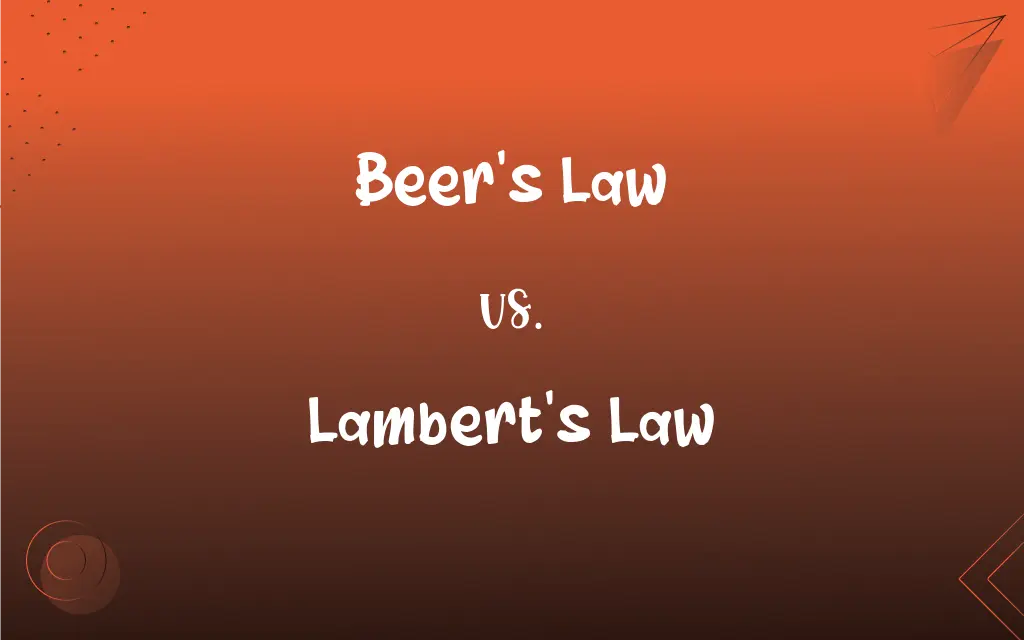Beer’s Law vs. Lambert’s Law: What's the Difference?
Edited by Aimie Carlson || By Janet White || Published on February 17, 2024
Beer's Law relates the absorption of light to the properties of the material through which the light is traveling, while Lambert's Law describes the decrease in intensity of light as it passes through a medium.

Key Differences
Beer's Law, also known as the Beer-Lambert Law, states that the absorbance of light by a medium is directly proportional to the concentration of the absorbing species in the medium. Lambert's Law, on the other hand, focuses on the attenuation of light as it travels through a substance, stating that the intensity decreases exponentially with the thickness of the material.
Beer's Law is often used in chemistry to determine the concentration of a solute in a solution by measuring light absorption. Lambert's Law is important in the field of optics and photometry, explaining how light intensity diminishes as it travels through an absorbing medium.
The formula for Beer's Law is A = εlc, where A is absorbance, ε is the molar absorptivity, l is the path length, and c is the concentration. Lambert's Law is represented by I = I0e^(-αx), where I is the intensity of light, I0 is the initial intensity, α is the absorption coefficient, and x is the thickness of the material.
In practical applications, Beer's Law helps in calibrating instruments like spectrophotometers for chemical analysis. Lambert's Law is used in designing optical systems and understanding light behavior in different media.
Beer's Law is ideal for dilute solutions where interactions between molecules are negligible, while Lambert's Law is more general, applicable to any type of medium, including gases and solids, provided the system follows the law's assumptions.
ADVERTISEMENT
Comparison Chart
Primary Focus
Relation of absorbance to concentration of a medium
Attenuation of light intensity through a medium
Application Field
Chemistry, specifically in solution concentration
Optics and photometry
Fundamental Formula
A = εlc
I = I0e^(-αx)
Key Parameters
Absorbance, concentration, path length
Intensity, absorption coefficient, material thickness
Practical Use
Spectrophotometry in chemical analysis
Designing optical systems, understanding light transmission
ADVERTISEMENT
Beer's Law and Lambert's Law Definitions
Beer's Law
Beer's Law states that absorbance is proportional to the concentration of an absorbing species.
Using Beer's Law, the scientist accurately determined the concentration of the solution.
Lambert's Law
Lambert's Law states that light intensity decreases exponentially with the thickness of an absorbing medium.
Lambert's Law explained the reduced light intensity after passing through the tinted glass.
Beer's Law
Beer's Law is a principle in chemistry for determining solute concentrations using light absorbance.
The lab technician used Beer's Law to calculate the unknown concentration in the test samples.
Lambert's Law
Lambert's Law helps in understanding the behavior of light in non-scattering media.
Lambert's Law was key in designing a light-based medical imaging device.
Beer's Law
Beer's Law is a foundational concept in spectroscopy for analyzing solutions.
In spectroscopy, Beer's Law facilitated the analysis of various chemical solutions.
Lambert's Law
Lambert's Law quantifies the relationship between material thickness and light absorption.
Using Lambert's Law, the scientist calculated the effect of material thickness on light transmission.
Beer's Law
Beer's Law quantifies the absorption of light in a solution based on solute concentration.
Beer's Law was crucial in the experiment to measure the light absorbed by the colored solution.
Lambert's Law
Lambert's Law is used to describe how light attenuates in a homogeneous medium.
The optical engineer applied Lambert's Law to predict the light loss in fiber optics.
Beer's Law
Beer's Law is used to describe the relationship between a solution's color intensity and its concentration.
By applying Beer's Law, the color intensity of the sample was correlated with its concentration.
Lambert's Law
Lambert's Law is fundamental in photometry for measuring light intensity.
Lambert's Law was used to calibrate the photometer for accurate light intensity measurements.
FAQs
What does Lambert's Law state?
It states that light intensity decreases exponentially with the thickness of an absorbing medium.
Where is Beer's Law commonly applied?
In chemistry for determining solute concentrations using spectrophotometry.
What does Beer's Law state?
It states that absorbance is directly proportional to the concentration of the absorbing species.
Where is Lambert's Law commonly applied?
In optics and photometry to understand light behavior in media.
Can Beer's Law be applied to turbid solutions?
No, it's ideal for dilute, non-interacting solutions.
What is the formula for Beer's Law?
A = εlc, where A is absorbance.
What is the formula for Lambert's Law?
I = I0e^(-αx), where I is the light intensity.
What is 'α' in Lambert's Law?
'α' is the absorption coefficient.
Does Lambert's Law apply to scattering media?
No, it applies to non-scattering, homogeneous media.
Can Lambert's Law be applied to colored glass?
Yes, to understand light attenuation through the glass.
How is Lambert's Law important in technology?
In designing optical devices and understanding light transmission in materials.
How does thickness affect Lambert's Law?
Greater thickness leads to more light attenuation.
Are there limitations to Lambert's Law?
Yes, it doesn't account for light scattering.
Is Beer's Law relevant in biology?
Yes, especially in biochemical analyses involving light absorbance.
Can Beer's Law be used with colored solutions?
Yes, particularly when the color intensity relates to concentration.
What is 'ε' in Beer's Law?
'ε' is the molar absorptivity coefficient.
What does 'l' represent in Beer's Law?
'l' represents the path length of light through the solution.
Are there limitations to Beer's Law?
Yes, in cases of high concentration or solution interactions.
Is Lambert's Law relevant in environmental studies?
Yes, in studying light penetration in atmospheric or water bodies.
How is Beer's Law important in industry?
For quality control and concentration measurements in manufacturing.
About Author
Written by
Janet WhiteJanet White has been an esteemed writer and blogger for Difference Wiki. Holding a Master's degree in Science and Medical Journalism from the prestigious Boston University, she has consistently demonstrated her expertise and passion for her field. When she's not immersed in her work, Janet relishes her time exercising, delving into a good book, and cherishing moments with friends and family.
Edited by
Aimie CarlsonAimie Carlson, holding a master's degree in English literature, is a fervent English language enthusiast. She lends her writing talents to Difference Wiki, a prominent website that specializes in comparisons, offering readers insightful analyses that both captivate and inform.
































































